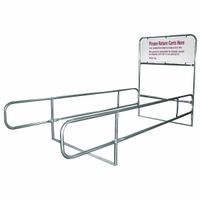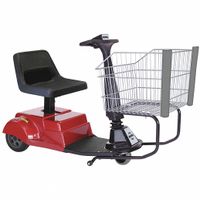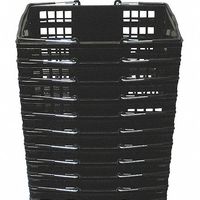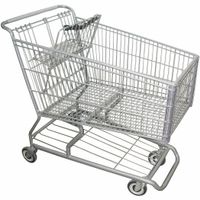Call +(254) 703 030 000 / 751 483 999 / 721 704 777
- Home
- Material Handling
- Transporting
- Carts Trucks
- Retail Carts
.....Read More
Frequently Asked Questions
What are the different types of shopping carts available?
There are several types of shopping carts available, each catering to different needs and preferences:
1. **Traditional Shopping Carts**: These are the standard metal or plastic carts found in physical retail stores. They come in various sizes, from full-sized carts to smaller, two-tiered versions for quick shopping trips.
2. **Electronic Shopping Carts**: These are motorized carts designed for individuals with mobility issues. They often include a seat and are battery-operated, allowing users to navigate the store with ease.
3. **Smart Shopping Carts**: Equipped with technology such as barcode scanners, touchscreens, and sensors, these carts help shoppers track their purchases, find items, and even check out without waiting in line.
4. **Basket Carts**: Smaller than traditional carts, these are designed for quick trips and smaller purchases. They often have two levels and are more maneuverable in tight store aisles.
5. **Collapsible Carts**: These are designed for easy storage and transport, often used in urban areas or for personal shopping. They can be folded and stored in a car trunk or closet.
6. **Online Shopping Carts**: In e-commerce, these are virtual carts that allow customers to select and review items before purchasing. They often include features like saving items for later, applying discount codes, and calculating shipping costs.
7. **Specialty Carts**: Designed for specific purposes, such as garden carts for outdoor stores or insulated carts for transporting perishable goods.
8. **Self-Checkout Carts**: Integrated with self-checkout systems, these carts allow customers to scan and pay for items as they shop, reducing the need for traditional checkout lines.
Each type of shopping cart is designed to enhance the shopping experience, whether in physical stores or online platforms.
How do motorized shopping carts work?
Motorized shopping carts, also known as electric shopping carts or mobility scooters, are designed to assist individuals with mobility challenges in navigating stores. These carts typically consist of a seat, a steering mechanism, and a basket for carrying items. They are powered by rechargeable batteries and are equipped with an electric motor.
The operation of a motorized shopping cart begins with the user sitting on the seat and using the controls, usually located on the handlebars or a control panel. The controls typically include a throttle, which is used to adjust speed, and a brake for stopping. Some models may also have a reverse function for maneuvering in tight spaces.
The electric motor, powered by the battery, drives the wheels of the cart. The battery is usually a lead-acid or lithium-ion type, providing sufficient power for several hours of use. The cart's speed is generally limited to ensure safety within the store environment, often ranging from 2 to 5 miles per hour.
Steering is accomplished through a tiller or handlebars, similar to those on a bicycle or scooter, allowing the user to navigate aisles and corners. The design of the cart ensures stability, with a low center of gravity and wide wheelbase to prevent tipping.
Safety features may include automatic braking systems, anti-tip wheels, and speed limiters. Some carts are equipped with a horn or bell to alert other shoppers of their presence.
When not in use, the carts are typically recharged at designated charging stations within the store. Regular maintenance is required to ensure the battery and motor function properly, and stores often have staff responsible for this upkeep.
What is the average cost of a shopping cart?
The average cost of a shopping cart can vary significantly based on several factors, including the type, size, material, and additional features. Generally, a standard metal shopping cart, like those commonly found in grocery stores, can range from $75 to $150 per unit. Larger or heavy-duty models, which are often used in warehouse stores, can cost between $150 and $300.
Plastic shopping carts, which are becoming more popular due to their lightweight and rust-resistant properties, typically cost between $100 and $200. Specialty carts, such as those designed for children or with added security features, can exceed $300.
Additional costs may arise from customization options, such as branding or specific color schemes, which can add $10 to $50 per cart. Maintenance and repair costs should also be considered, as well as potential bulk purchase discounts, which can reduce the per-unit price for large orders.
Overall, the average cost of a shopping cart is influenced by the specific needs and preferences of the retailer, as well as the volume of purchase.
How do stores prevent shopping cart theft?
Stores prevent shopping cart theft through several methods:
1. **Electronic Wheel Locks**: Many stores use electronic systems that lock the wheels of shopping carts if they are taken beyond a certain perimeter. This is often achieved through a buried cable around the store's parking lot that sends a signal to lock the wheels.
2. **Cart Corral Systems**: Designated areas in parking lots, known as cart corrals, encourage customers to return carts. This reduces the likelihood of carts being abandoned and subsequently stolen.
3. **Physical Barriers**: Some stores install physical barriers or bollards at exits to prevent carts from being taken out of the store or parking area.
4. **Cart Retrieval Services**: Stores may employ or contract services that retrieve carts from surrounding areas, reducing the number of carts that are permanently lost.
5. **Security Personnel**: Having security staff monitor exits and parking lots can deter theft and ensure carts are returned.
6. **Signage and Warnings**: Posting signs that inform customers about the consequences of cart theft can act as a deterrent.
7. **Deposit Systems**: Some stores implement a deposit system where customers insert a coin to release a cart, which is returned when the cart is brought back.
8. **Cart Design**: Designing carts with unique features or branding makes them less appealing for theft and easier to identify if stolen.
9. **Community Engagement**: Stores may work with local communities to raise awareness about the impact of cart theft and encourage responsible behavior.
10. **Surveillance Cameras**: Installing cameras in parking lots and store exits can help monitor cart usage and deter theft.
What materials are shopping carts made from?
Shopping carts are primarily made from a combination of materials to ensure durability, functionality, and cost-effectiveness. The main materials used include:
1. **Steel**: Most traditional shopping carts are made from steel, which provides strength and durability. The steel is often coated with a layer of zinc or chrome to prevent rust and corrosion, ensuring longevity even with frequent use and exposure to the elements.
2. **Plastic**: High-density polyethylene (HDPE) or other durable plastics are increasingly used for shopping carts. Plastic carts are lightweight, resistant to rust, and can be molded into various shapes and colors. They are also quieter when moved and less likely to damage store fixtures or vehicles.
3. **Aluminum**: Some shopping carts are made from aluminum, which is lighter than steel and resistant to rust. Aluminum carts are often used in environments where weight is a concern, such as in airports or smaller retail stores.
4. **Wire Mesh**: The basket portion of many shopping carts is made from wire mesh, typically constructed from steel or aluminum. This design allows for visibility of the contents and easy cleaning.
5. **Rubber or Plastic Wheels**: The wheels of shopping carts are usually made from rubber or a durable plastic like polyurethane. These materials provide smooth movement and reduce noise. Some wheels may also have metal components for added strength.
6. **Fabric or Canvas**: In some specialized carts, such as those used in smaller stores or for personal use, fabric or canvas may be used for the basket or bag portion. These materials are lightweight and can be easily folded or collapsed.
These materials are chosen to balance cost, durability, ease of maintenance, and user convenience, making shopping carts a practical tool for both retailers and consumers.
How do shopping cart corrals help in organizing carts?
Shopping cart corrals play a crucial role in organizing carts by providing designated areas for customers to return their carts after use. This system helps maintain order in parking lots and store entrances, reducing clutter and potential hazards. By having a specific location for carts, customers are more likely to return them, minimizing the number of stray carts that can obstruct parking spaces or cause damage to vehicles.
Corrals also streamline the process for store employees tasked with collecting carts. Instead of searching the entire parking lot, employees can focus on a few centralized locations, making the retrieval process more efficient and less time-consuming. This efficiency can lead to cost savings for the store, as fewer labor hours are needed for cart collection.
Moreover, organized cart storage enhances the shopping experience by ensuring that carts are readily available and in good condition for the next customer. This convenience can improve customer satisfaction and encourage repeat business.
In addition, cart corrals contribute to safety by reducing the risk of accidents. Stray carts can roll into vehicles or pedestrians, causing damage or injury. By keeping carts contained, corrals help prevent such incidents.
Finally, cart corrals can have an aesthetic benefit, as a well-organized parking lot appears more orderly and inviting. This positive impression can enhance the store's image and attract more customers.
Overall, shopping cart corrals are an effective tool for maintaining organization, improving efficiency, enhancing customer experience, ensuring safety, and promoting a positive store image.
What are the benefits of using a shopping cart in retail environments?
A shopping cart in retail environments offers numerous benefits that enhance both the customer experience and the retailer's operational efficiency.
For customers, shopping carts provide convenience and ease of shopping. They allow shoppers to collect and transport multiple items without physical strain, encouraging them to spend more time in the store and potentially purchase more products. This ease of use can lead to increased customer satisfaction and loyalty. Additionally, shopping carts can accommodate a variety of items, from groceries to larger goods, making them versatile for different shopping needs.
For retailers, shopping carts can lead to increased sales. When customers have the means to carry more items comfortably, they are likely to buy more, boosting the store's revenue. Shopping carts also facilitate a smoother shopping flow, reducing congestion in aisles and enhancing the overall shopping experience. This can lead to positive word-of-mouth and repeat business.
Operationally, shopping carts can be equipped with technology such as barcode scanners or RFID readers, streamlining the checkout process and reducing wait times. This integration can improve inventory management and provide valuable data on shopping patterns and customer preferences, aiding in better stock management and marketing strategies.
Moreover, shopping carts can serve as mobile advertising platforms. Retailers can use them to display promotions, advertisements, or store branding, further engaging customers and driving sales.
In summary, shopping carts are a crucial component in retail environments, offering convenience and efficiency for customers while providing retailers with opportunities to increase sales, improve operational processes, and enhance customer satisfaction.



